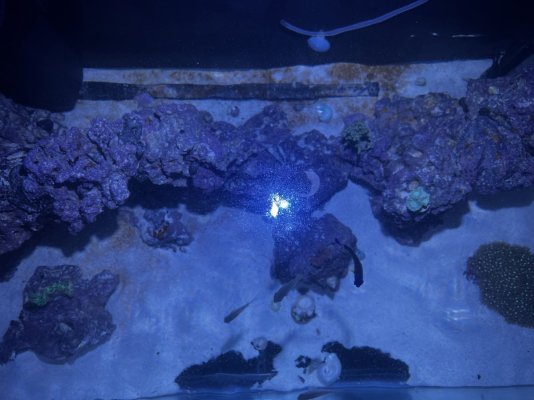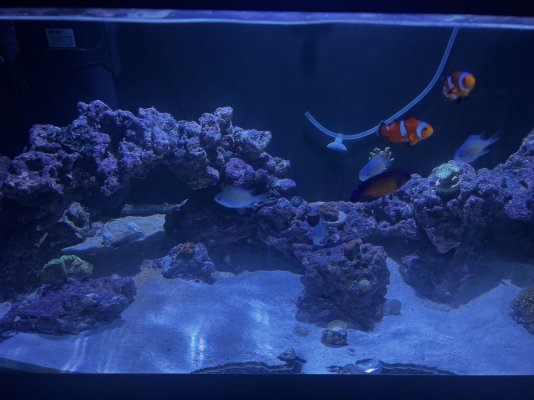Hello reefers,
I’ve been battling dinos for the past few months (stayed in denial and didnt confirm until about a month ago) and I think I’m at a crossroads.
When I first confirmed that I had dinos (likely large cell amphidium), I immediately began treating. I already had a uv filter due to cloudy water so I kept using that, and after going to my LFS I decided to go nuclear and apply dinox due to the stubborn nature of LCA and honestly being tired of back-to-back problems with my reef tank. I followed the instructions and stopped water changes, turning off the filter, and reducing the light cycle. I was really happy to see that the dinos largely vanished from view after a few treatments and could actually see the sand again!
Unfortunately, about 2.5 weeks in the treatment seemed to plateau as there was still some light brown dots in the back of the tank. Moreover, what I presume the lack of light and presence of dinox in the tank was having a negative impact on the fish and coral. My torch stopped opening, and I eventually lost my Yellow Watchman Goby and Cleaner Shrimp (unsure exactly why but I presume due to the aggressive treatment). After my first fish died I decided to stop dosing DinoX and increase the light cycle. This seems to have prompted a resurgence of the dinos as they’ve begun taking over the sandbed (see attached picture). Although my nitrates and phosphates are decent/high (23.5 ppm and 0.31 ppm, respectively), I think the dinox and earlier application of chemiclean elimanated the competition as I can’t see any algae growth.
With the overexplained backstory out of the way, here is my dilemma:
My plan since I started the battle was to introduce some competition after the treatment to prevent a resurgence. I bought some copepods and live phyto from Algaebarn so I can introduce and sustain both lifeforms in my tank. Additionally, I bought the LSA, Wondermud, and coralline algae booster from IPSA to add more biodiversity. I just got the live phyto and pods today and am expecting the IPSA stuff next week.
I’m afraid that I already missed the window as the dinos are already spreading and the earliest I’ll be able to add some competition is next week.
My question is essentially what I should do now. From my perspective, the two options are:
1. Do a water change (since it’s been a week since the last dinox application) and wait until next week to add the pods, IPSA materials, and start dosing phyto.
Pros: likely best option to preserve fish/coral safety
Cons: risk dinos spreading to the point where competitors can’t gain a foothold and essentially throw the $200 on IPSA/Algaebarn down the drain
2. Restart the dinox regiment to beat back the dinos and apply biological treatments after the second treatment phase.
Pros: will likely beat back dinos and give competitors a chance to establish themselves
Cons: can hurt/stress fish and corals and potentially lead to more losses. Moreover, can hurt the competitors and kill them off upon introduction to system which would also lead to a loss of the $200 invested
I’m pretty demoralized by this fight and by losing 2 inhabitants and just don’t know how to proceed. If anyone can provide insight on which method would be best, or if there’s a third option I’m missing, I would be eternally grateful.
Some other (sorta related) questions:
1. How long can copepods survive in an algaebarn jar (in case I wait to add them)?
2. Can copepods survive in dinox (in case I add them now)?
3. Can copepods eat dead phyto (temporarily while I wait for the live culture to mature)?
4. What happens if I add competitors while DinoX is in the tank?
Lastly, my params AO March 8th (I’m planning to retest tonight):
pH: 8.2
Alk: 8.4 dKH
Ca: 466 ppm
Phos: 0.31 ppm
Nitrate: 23.5 ppm


I’ve been battling dinos for the past few months (stayed in denial and didnt confirm until about a month ago) and I think I’m at a crossroads.
When I first confirmed that I had dinos (likely large cell amphidium), I immediately began treating. I already had a uv filter due to cloudy water so I kept using that, and after going to my LFS I decided to go nuclear and apply dinox due to the stubborn nature of LCA and honestly being tired of back-to-back problems with my reef tank. I followed the instructions and stopped water changes, turning off the filter, and reducing the light cycle. I was really happy to see that the dinos largely vanished from view after a few treatments and could actually see the sand again!
Unfortunately, about 2.5 weeks in the treatment seemed to plateau as there was still some light brown dots in the back of the tank. Moreover, what I presume the lack of light and presence of dinox in the tank was having a negative impact on the fish and coral. My torch stopped opening, and I eventually lost my Yellow Watchman Goby and Cleaner Shrimp (unsure exactly why but I presume due to the aggressive treatment). After my first fish died I decided to stop dosing DinoX and increase the light cycle. This seems to have prompted a resurgence of the dinos as they’ve begun taking over the sandbed (see attached picture). Although my nitrates and phosphates are decent/high (23.5 ppm and 0.31 ppm, respectively), I think the dinox and earlier application of chemiclean elimanated the competition as I can’t see any algae growth.
With the overexplained backstory out of the way, here is my dilemma:
My plan since I started the battle was to introduce some competition after the treatment to prevent a resurgence. I bought some copepods and live phyto from Algaebarn so I can introduce and sustain both lifeforms in my tank. Additionally, I bought the LSA, Wondermud, and coralline algae booster from IPSA to add more biodiversity. I just got the live phyto and pods today and am expecting the IPSA stuff next week.
I’m afraid that I already missed the window as the dinos are already spreading and the earliest I’ll be able to add some competition is next week.
My question is essentially what I should do now. From my perspective, the two options are:
1. Do a water change (since it’s been a week since the last dinox application) and wait until next week to add the pods, IPSA materials, and start dosing phyto.
Pros: likely best option to preserve fish/coral safety
Cons: risk dinos spreading to the point where competitors can’t gain a foothold and essentially throw the $200 on IPSA/Algaebarn down the drain
2. Restart the dinox regiment to beat back the dinos and apply biological treatments after the second treatment phase.
Pros: will likely beat back dinos and give competitors a chance to establish themselves
Cons: can hurt/stress fish and corals and potentially lead to more losses. Moreover, can hurt the competitors and kill them off upon introduction to system which would also lead to a loss of the $200 invested
I’m pretty demoralized by this fight and by losing 2 inhabitants and just don’t know how to proceed. If anyone can provide insight on which method would be best, or if there’s a third option I’m missing, I would be eternally grateful.
Some other (sorta related) questions:
1. How long can copepods survive in an algaebarn jar (in case I wait to add them)?
2. Can copepods survive in dinox (in case I add them now)?
3. Can copepods eat dead phyto (temporarily while I wait for the live culture to mature)?
4. What happens if I add competitors while DinoX is in the tank?
Lastly, my params AO March 8th (I’m planning to retest tonight):
pH: 8.2
Alk: 8.4 dKH
Ca: 466 ppm
Phos: 0.31 ppm
Nitrate: 23.5 ppm




















